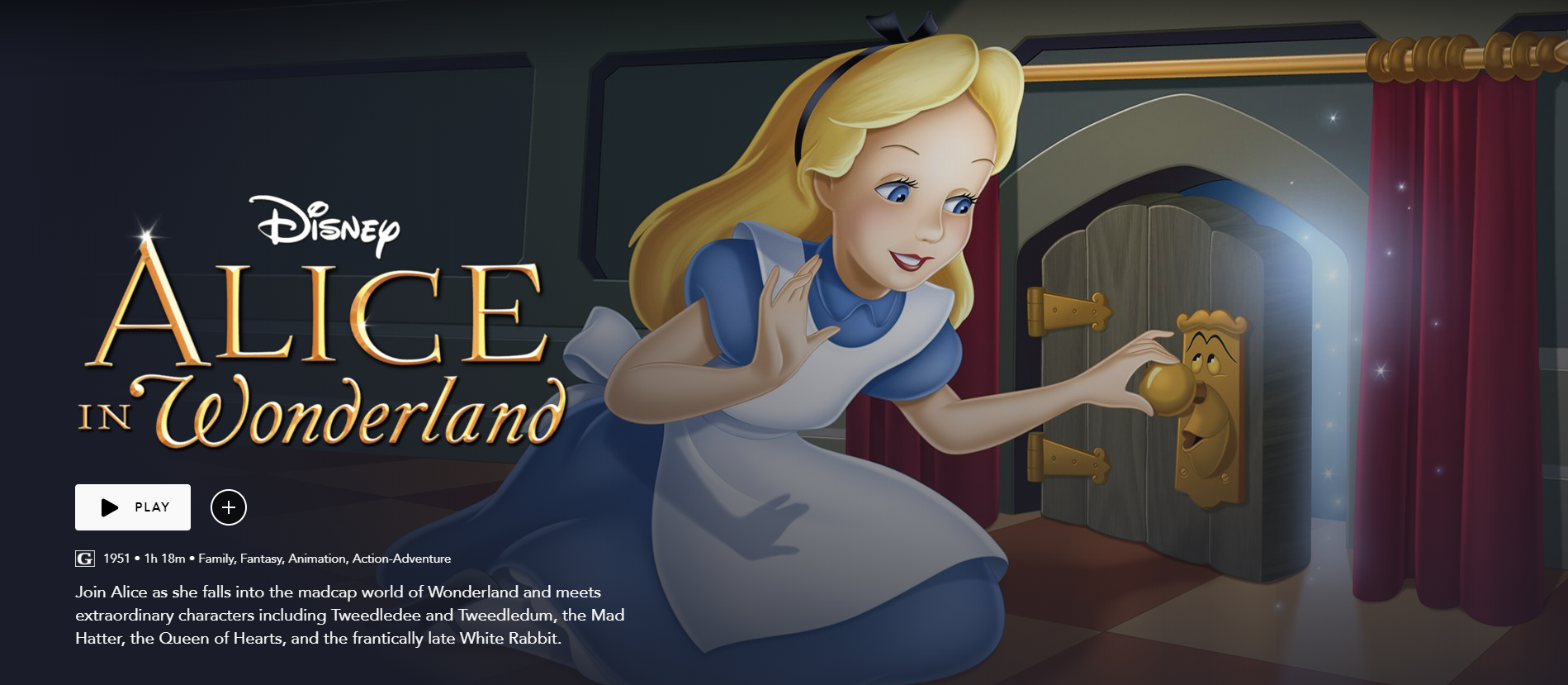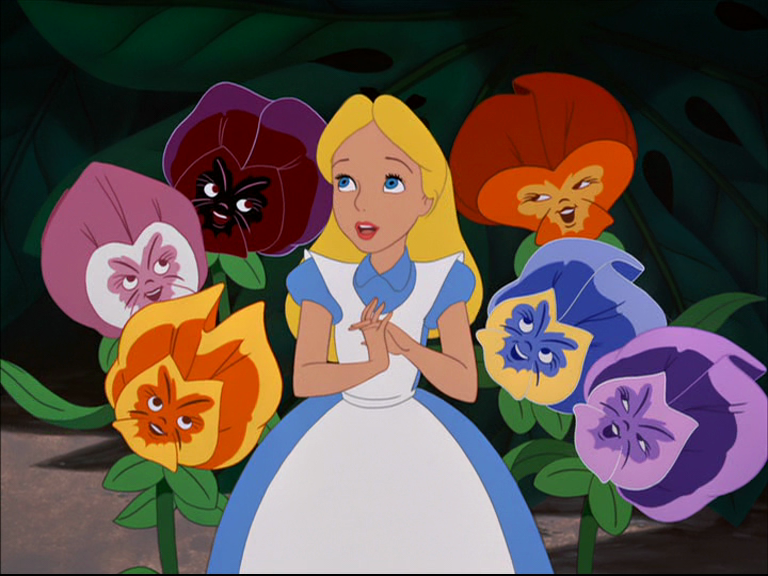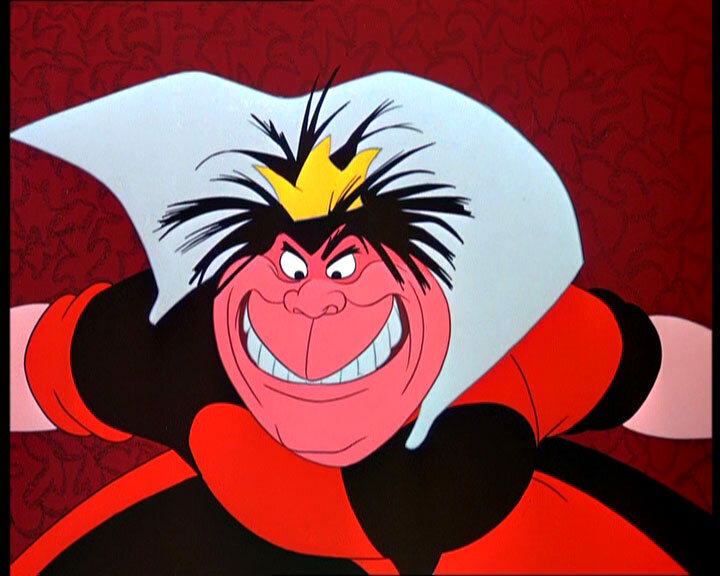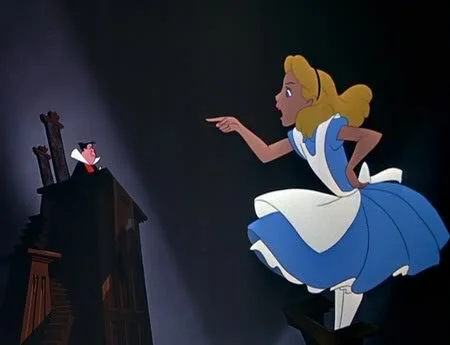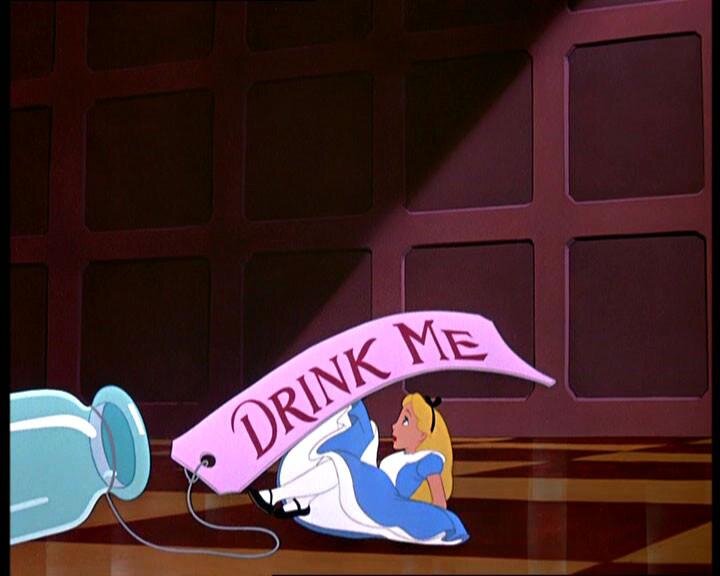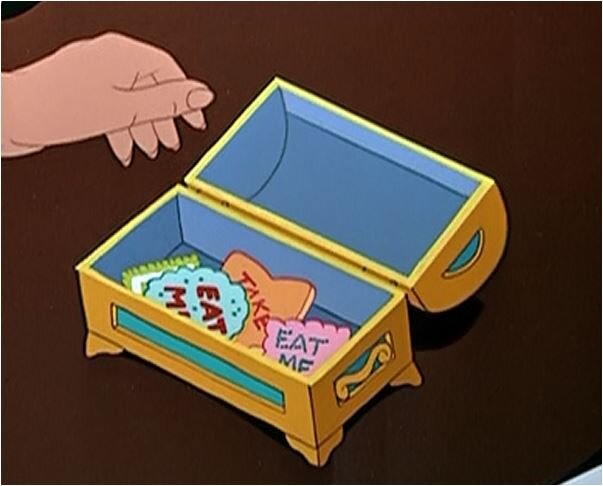Review: Alice in Wonderland (DMC #14)
A very merry unbirthday to all of you! Since 2020 is a leap year, you get 365 unbirthdays. Imagine that!
This week we watched the fourteenth movie in the Disnerd Movie Challenge, Alice in Wonderland (the original 1951 animated version, not the live action one from 2010—that comes later in the challenge). In case it’s been a while, we’ve included our synopsis below. If you watched with us last night, feel free to skip ahead to our review!
Synopsis
Young Alice is bored with the history lesson her sister is reading and longs for an adventure, thinking of a place where everything is nonsense. While she lounges by a river she sees a passing White Rabbit in a waistcoat, carrying a large pocket watch and crying out that he’s “late for a very important date.” He takes off into a rabbit hole and Alice gives chase, falling through the pit into a strange place known as Wonderland. She tries to follow the Rabbit through a tiny door, but she can only follow through by shrinking herself. After a couple mishaps involving shrinking and then growing too large, Alice makes it through the door and continues her chase. Along the way she meets the Dodo, and later on Tweedledee and Tweedledum, who tell her the tale of “The Walrus and the Carpenter.” Alice eventually finds the Rabbit at his house, but he confuses her for his maid and sends her to get his gloves. Another growth incident causes Alice to be mistaken for a monster, and the passing Dodo “helps” the Rabbit by burning the house down to “smoke the monster out.” Alice escapes by shrinking to a small size again, eventually coming to a meadow of flowers. While the flowers originally welcome her, they soon mistake her for being a weed and force her out of the garden.
Alice then comes across a hookah-smoking Caterpillar, who is deeply insulted at Alice’s stress over her current small height and turns into a butterfly. Alice is able to return to normal height and meets the Cheshire Cat while wandering the woods. The Cheshire Cat directs her to the Mad Hatter and the March Hare to learn of the Rabbit’s location. She joins in the pair’s Mad Tea Party, also meeting the Dormouse, and celebrates “unbirthdays.” While the Rabbit shows up at the party, further misadventures keep Alice from meeting him, and she leaves the party. Eventually she is lost in the woods and, having gotten fed up with Wonderland’s nonsense, cries and wishes to go home. The Cheshire Cat appears and tells her to meet with the Queen of Hearts in order get home. While at the castle the Queen forces Alice to play croquet with her, but the game is rigged to allow the Queen to win. The Cheshire Cat pulls a prank on the Queen, who assumes Alice to be the prankster, and though she immediately calls “off with her head!,” the timid King suggests a trial. The trial is just a sham, and chaos ensues when the Cheshire Cat appears again, only to frighten the Dormouse. Alice uses the commotion to grow large, briefly insulting the Queen before she returns to normal size once more. She runs away from the courtroom as the Queen and several others chase her, back through Wonderland and to the locked door. The doorknob informs Alice that she is already outside, asleep. Alice frantically calls to herself to wake up, and she eventually does. Though she remembers her adventure and immediately starts talking about it, her sister is completely baffled, and the two return home.
Thoughts Before Watching
Megan: To be honest, I’ve never been a huge fan of Alice (except for the Alice in the Once Upon A Time spin-off TV series, Once Upon A Time in Wonderland, because that Alice was a total badass!) I read the book Alice’s Adventures in Wonderland by Lewis Carroll several years ago, and it is in many ways more bizarre than the film that Disney created. I also saw the live action remake not too long ago, but it’s been ages since I’ve seen the animated film. I’m curious to see how much I remember.
Kevin: I was a member of my elementary school’s choir way back when. We put on two major shows a year, and one of those shows was all Disney music (so yeah, very exciting!). One of the songs we sang was “All in the Golden Afternoon.” To this day it’s the most memorable thing to me about the animated version of Alice in Wonderland. I’m with Megan here on our view of Alice; not much of a fan, but very much loved the TV show mentioned before. I’ve never read the book or seen the live action films either. We’ll see what I come away with after this viewing.
Thoughts After Watching
Wonderland is visually colorful.
Kevin: My first thought after the credits rolled was how beautiful the colors were. As an artist and animation enthusiast, visuals will certainly be a running theme throughout these reviews, so I do hope you won’t get bored of me talking about it! The artwork of Alice in Wonderland is a step above Cinderella; it’s incredibly rich and colorful in comparison. The opening scene is beautiful enough, and then Wonderland itself is nothing short of vibrant—think especially of the flower garden. It isn’t surprising that the visuals are as gorgeous as they are considering this movie was the most expensive film Disney made at the time. The project was technically in development for many years. In fact, Walt apparently wanted to adapt the story for film as early as the 1920s and originally planned for it to be the first animated feature, but it was shelved for a while. The film’s production cost is clearly seen in the final product.
This passes the Bechdel test, but…
Megan: If Wonderland has anything going for it it’s that it comes a few steps closer to gender parity in the number of male and female characters we meet. This is largely why it passes the Bechdel test—Alice has conversations with her sister, her cat Dinah to some degree, the flowers, and the Queen, and only some of those conversations are about a male character. However, I still have some issues with the nature of these conversations since the majority of the conversations between women in Wonderland are more critical. For example, when Alice meets the flowers the conversation starts off pleasant enough, but when the flowers cannot identify what sort of flower Alice is they quickly assume that she must be a weed, thereby marking her as “other.” After making fun of her “petals” and “stems” they scare her off, saying “We don’t want weeds in our bed.” And it isn’t just the flowers that are antagonistic in this exchange. Before Alice leaves them she threatens “If I were my right size I could pick every one of you.” Perhaps Alice’s response is warranted, given what she just went through, but when she walks away saying “Seems to me they could learn a few things about manners,” we in the audience can’t help but think Alice, too, still has a few things to learn.
Ugh, the Queen!
Megan: The Queen is no better. While I appreciate that she is a woman in power who seems to command more power than the King, it seems to me like the creators were using her character to make an argument as to why men should not cede power to a woman. I mean look at her: she has a terrible temper, she wants to behead everyone, and everyone (rightly) lives in fear of her. Not to mention the animators chose to make her fat and ugly (her face shape is more akin to an ape than a human with her overly large mouth) when all prior animated human female characters were held to a (somewhat unattainable) slender and beautiful ideal. If this were a one-off situation, maybe it wouldn’t be a problem, but this unfortunately begins a terrible pattern of “fat=evil” and continues a pattern of “queen=evil” (which, can we just take a moment to say how crazy it is that “queen=evil” while “princess=good,” yet the whole point of being a princess is that you’re in line to eventually become queen? Thank goodness Frozen and Frozen 2 helped flip that script!) I get that we’re not supposed to like the Queen of Hearts, but does she have to be such an insulting caricature toward women and women in power?
Kevin: Taking into account how the Queen and King interact, it’s also worth noticing how this contrasts with other male-female interactions. While in one instance you have the Queen wielding power over the King, as Megan said, the Queen’s character and appearance is abhorrent. Alice, on the other hand, is interrupted in almost every single conversation she has with men or male characters. Tweedledee and Tweedledum, the Caterpillar, the Mad Hatter, and March Hare all have at least one moment where they speak over Alice before she can get in a word. In some cases that’s all the particular male character does. Yes, the male characters do speak over each other at times, and the Queen interrupts Alice as well. However, in that second example it’s more to do with the Queen’s power over Alice. It’s clear we’re meant to dislike the Queen. What is not clear or even implied is whether the male characters are also supposed to be unlikable (though they’re certainly not likable). I understand this was a running theme in the original story, but I have a feeling it served a narrative purpose. With this film and a lack of further context, interruption here comes off less of a theme and more of a bad joke.
Megan: Agreed, and what’s more troubling is the implication that not only are men’s voices/thoughts/opinions more important than Alice’s, but any adult’s voice/thoughts/opinions are more important than a child like Alice’s. While the audience feels Alice’s frustration at trying to reason with these unreasonable characters and make her voice heard, when the dream ends we still don’t see Alice being heard. Only when she grows big enough to tower over the Queen in the courtroom does she have the courage and the platform to speak her mind, but she quickly loses both as she shrinks back to her usual size. Then, upon waking from the dream, she appears to be the one speaking nonsense when she tries to explain her adventures to her sister.
Speaking of caricatures, Wonderland is full of them.
Megan: In viewing this film as an adult I now recognize many of the characters in Wonderland as caricatures of the problems we face on a regular basis and some of the “nonsense” we encounter. For example, the Dodo, who insists that the best way for everyone to get dry is to run in circles…right in the path of the waves. When Alice tries to tell him that this isn’t a good way to get dry, the Dodo answers “Nonsense! Why I’m as dry as a bone already!” When we next see the Dodo in Wonderland, he is called over by the White Rabbit to help get the “monster” (an overgrown Alice) out of his house, and the Dodo’s solution is to smoke the monster out…by burning the house to the ground. To make matters worse, once Alice has shrunk and left the house, there is no need to continue building a fire, and yet the Dodo goes ahead with it anyway. How many of us have encountered a boss or another authority figure who insists that the solution to a problem is doing the same inefficient process over and over—because, hey, it works great for the person who doesn’t have to do the work! And how many of us have encountered people who insist on following through with a terrible plan rather than making adjustments when circumstances change? I also find it ironic that the running in circles is referred to as a “Caucus Race.” By definition, a caucus is a closed meeting of a group of persons belonging to the same political party or faction usually to select candidates or to decide on policy. It seems to me Lewis Carroll must have been taking a jab at the politicians of his time when he wrote this particular Caucus Race scene into Alice’s Adventures in Wonderland and chose to make this character an extinct dodo bird.
Caricatures lack character.
Megan: There are many more caricatures throughout Wonderland—the Tweedles, the Mad Hatter and March Hare, the playing cards…pick any character, really. However, that is all they are—caricatures. They lack any proper character development, and so they are no more than one-dimensional figures placed along Alice’s journey. Even Alice, who has the most character development of everyone, is still not all that developed. Her primary character arc is to go from insisting that in a world of her own making “everything would be nonsense” to crying alone in the dark woods of Wonderland insisting “I’ve had enough nonsense. I want to go home.” In fact, there is so much nonsense that it’s honestly hard to remember the plot of this movie. Did she meet the Caterpillar before or after the White Rabbit’s house? Or was that after the tea party? It all begins to blur together.
Kevin: Yeah, you know that there’s too much nonsense when even your main character, who originally longed for such, has had enough. It’s hard to follow the story when there’s… well, no real plot. Everything is too chaotic and random that it’s hard to keep up with who’s doing what. But then again, the very nature of the story and Wonderland itself means there wouldn’t be order and structure. It’s also implied that Alice was merely having a dream, which would explain all the randomness.
Megan: To that point, I think that’s how Lewis Carroll was able to get away with such a haphazard plot—because it all turns out to be a dream. Granted, I don’t think many writers today can get away with that since today’s audiences crave a bit more of a logical arc to the story. Even the live action Alice in Wonderland had to add in a little something more to keep up with the times.
Kevin: I’m kind of curious to know just how bizarre this story really is. Reminder to myself to put it on my “to-read” list.
“If one drinks much from a bottle marked ‘Poison,’ it's almost certain to disagree with one sooner or later.”
Megan: I can’t help but see an analogy to drugs, alcohol, and peer pressure in the “drink me” and “eat me” items throughout Wonderland. Here are all these drinks and foods enticing Alice to consume them, in a land that has clearly established cannot be trusted. Though Alice gives herself the advice “Better read it first, for if one drinks much from a bottle marked ‘Poison,’ it's almost certain to disagree with one sooner or later,” she shrugs off her own “good advice” and drinks from the bottle anyway—with somewhat disastrous consequences. One would think those consequences would be enough for her to learn her lesson, yet when she encounters cookies that say “eat me” she simply replies “don’t mind if I do” and eats one, this time without bothering to give herself advice. I can’t help but wonder if this Alice might grow up to be an addict. Perhaps this is why everyone in Wonderland is “mad”—perhaps they’re all intoxicated by “eat me” or “drink me” poisons of their own.
Shout out for cute animals!
Kevin: Brief side note here, but once more we need to give a shout out to cute animals (and animal inspired). Those animal-flower hybrids in the Meadow of Living Flowers, such as the dandy lion, tiger lily, and dandy pup, are great examples.
Megan: Same goes for the dog- and cat-erpillars and the bread-and-butterflies.
Kevin: Alice’s cat Dinah is also adorable; we both loved how she interacted with Alice. While Figaro from Pinocchio had a full on personality, there isn’t time or even a purpose to develop Dinah, but she still has a sense of individuality and shows she understands humans, like when she shakes her head after Alice asks her a question and waves goodbye to Alice as she falls through the rabbit hole. It’s actually an interesting contrast to the Cheshire Cat, who is just all sorts of whimsical and, at times, creepy.
Not all child actors have tragic stories.
Kevin: In our last review I talked a bit about the life of Bobby Driscoll. While his life was tragically short, the voice actress behind Alice has arguably lived a fulfilling life. Kathyrn Beaumont not only voiced Alice, but also Wendy in Peter Pan. She had small roles, but she still caught the attention of Walt Disney. Though she was born in England, she relocated to Los Angeles, California, to continue her career. In addition to her voice acting talents she also served as the performance model for both of her Disney characters, providing live-action reference to help the animators. She went on to receive a degree in education, working as an elementary school teacher in L.A. for over thirty years. (Man, I wish she had been my teacher back then! Though I probably would’ve geeked out a little had I known who she was.) Beaumont was named a Disney Legend in 1998, and continued to be the voice of Alice and Wendy well into the early 2000s before officially retiring. It’s well known that the entertainment industry is a challenging and sometimes cutthroat business, especially for young talent, but it’s wonderful to know that many find success and enrichment, whether inside or outside the business.
Kevin: Alice in Wonderland is far better than any of the war-time package films, but I didn’t enjoy it as much as Cinderella. The movie is just a bit too random for my taste, and it’s hard to get on the side of any characters because they’re such wild caricatures. And since Alice herself isn’t all that likable, there are no real stakes, and nothing much to get emotionally invested in. The film’s best features are really its art and its music (the soundtrack is fun to listen to and sing along with). With all of this said though, I will take an adventure through Wonderland over another package film.
Verdict
Megan: 4
Kevin: 4
Final score: 4
What did you think of Alice in Wonderland? Tell us in the comments!
